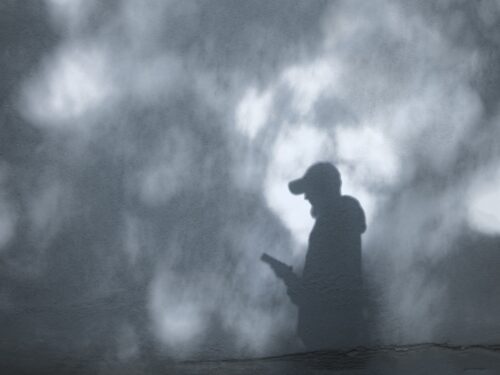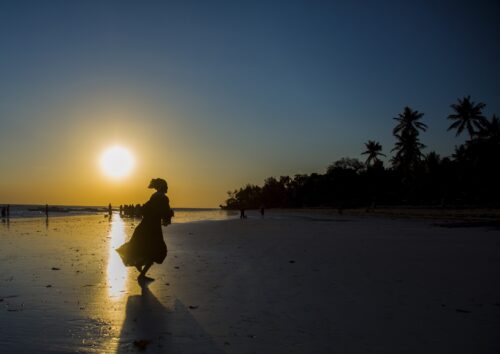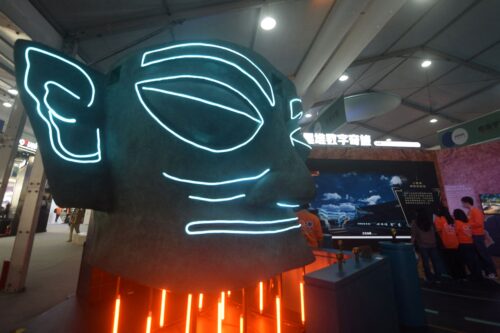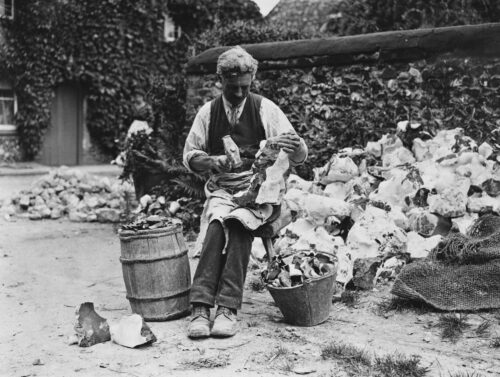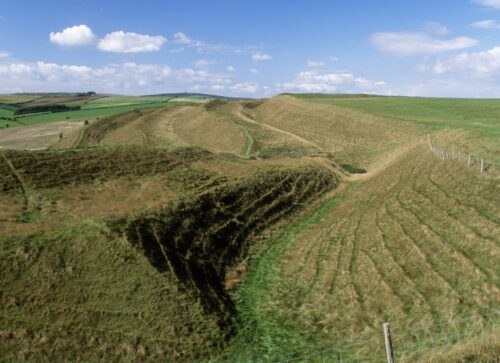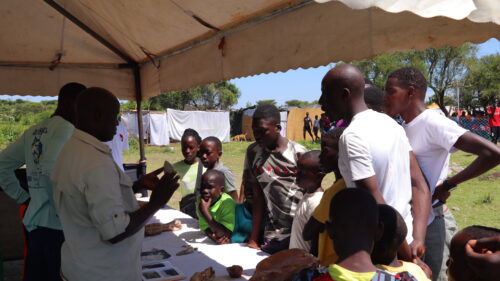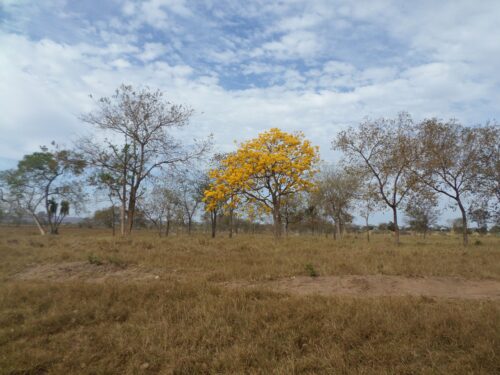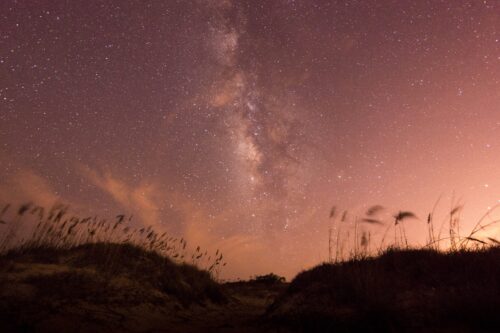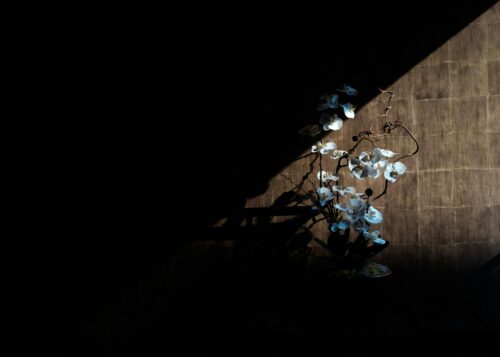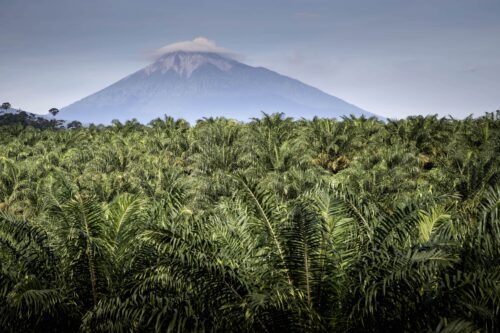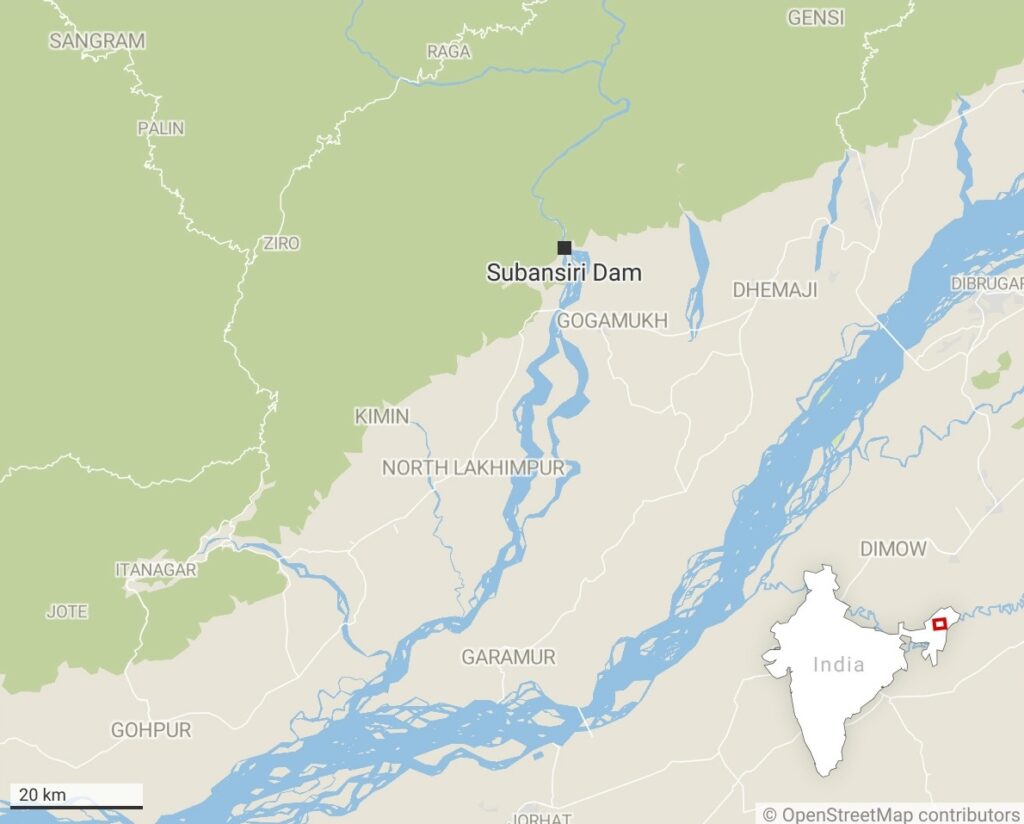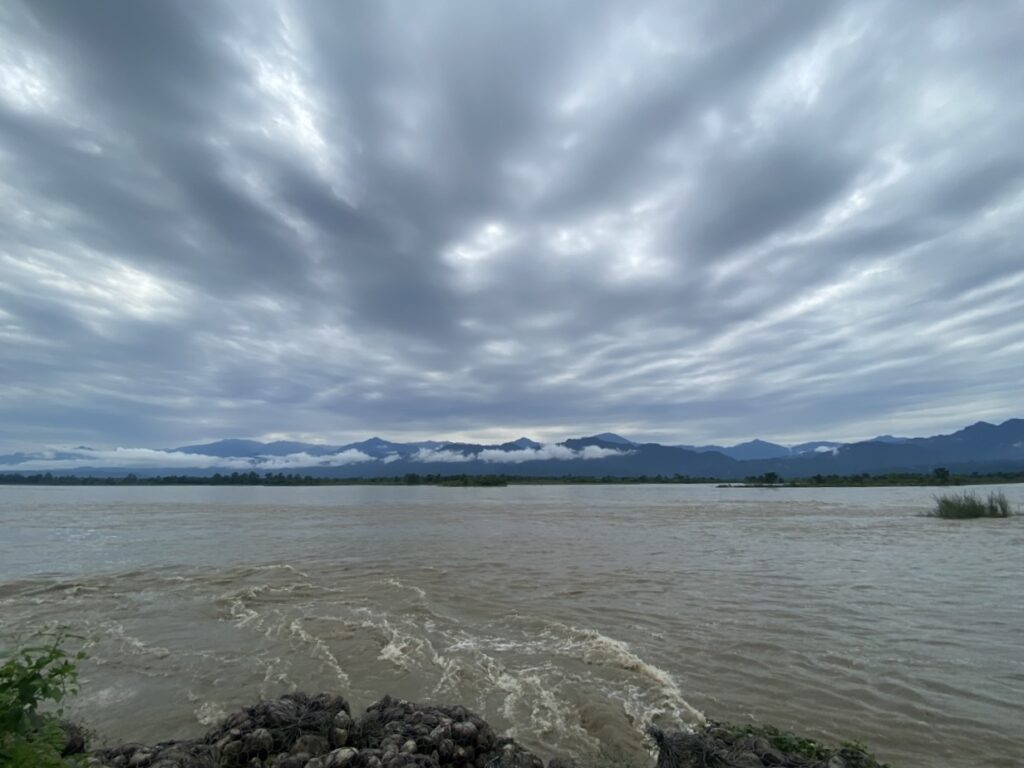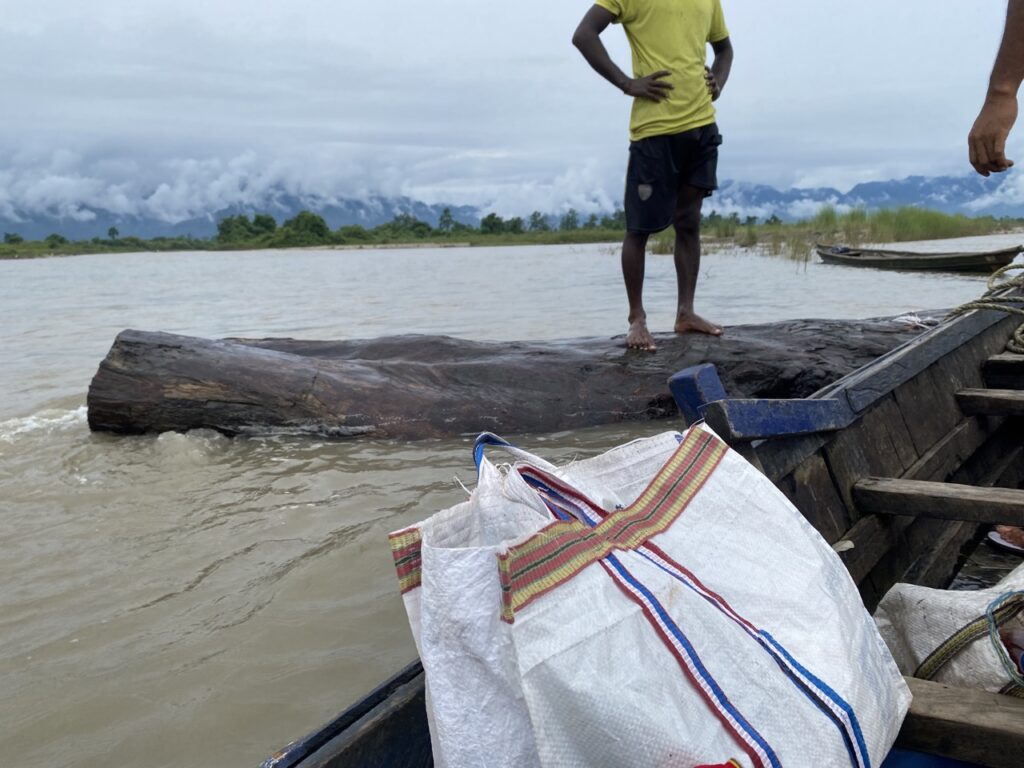How a Megadam Disrupts the Flow of Water—and Money
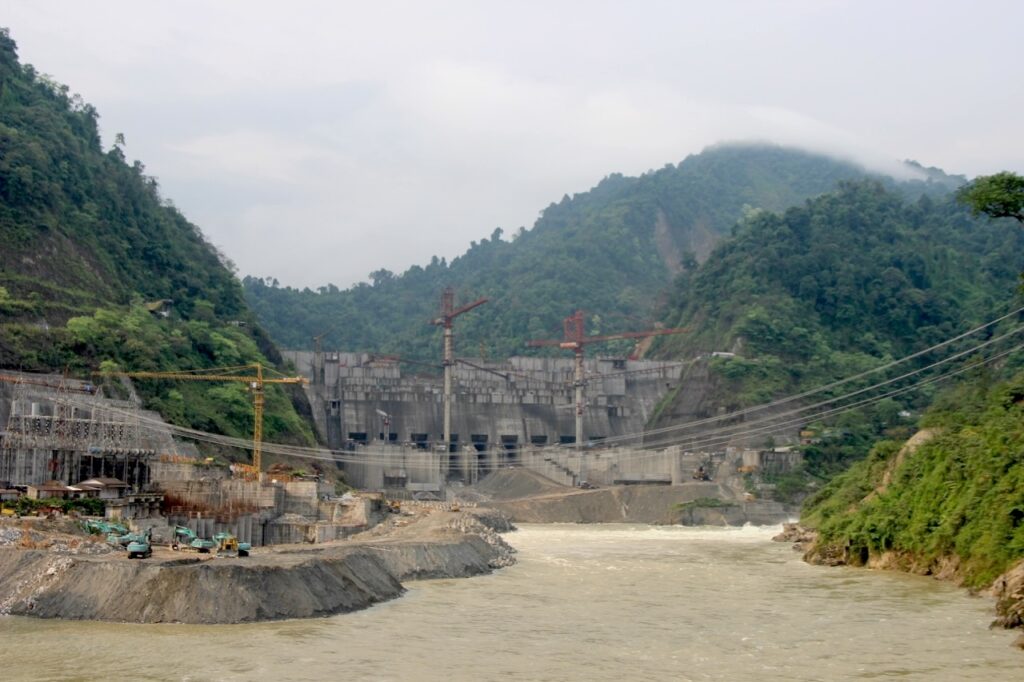
At the peak of summer monsoon, I woke to rain pelting the tinned roof. The noise hurt my eardrums. Surely venturing onto the river in this weather would be disastrous. I was hoping that Bimal would not call. [1] [1] All names have been changed to protect people’s identities. But he did.
A few hours later, we were on the banks of the Subansiri River waiting for our ride, a wooden boat piloted by a man named Ratan. The waterway was almost triple the size of the Hudson River in New York. Fast currents rolled over one another, making whirlpools in quick succession. A light monsoon shower was adding more water.
Bimal, who makes his living tending water buffalos along the river, turned to me and said in Assamese, “Jimane besi paani, simane besi poisa.” (“More water means more money.”) I didn’t understand what he meant, but we set off on our journey anyway.
In 2023, I lived in Bimal’s village next to the Subansiri River in Assam, a central state of Northeast India. As a Ph.D. candidate in anthropology at the University of North Carolina, Chapel Hill, my dissertation research brought me there to study how a hydroelectric dam, under construction since 2005, will impact the river and local residents in Assam and the neighboring state of Arunachal Pradesh. After two decades, the dam is expected to finally start generating electricity in 2025 and be fully operational in 2026.
The 2000-megawatt Subansiri Lower Hydroelectric Dam (SLHEP) is the flagship project of the government of India’s ambitious but highly contested plan to build 168 hydropower dams in the region. This plan has earned the Northeastern region a new identity as the nation’s “future powerhouse.” But ensuring future energy is only one part the story. The dams and other large-scale infrastructures being built in this region—including roads, railways, and bridges—appear to be part of efforts to help India strengthen its political claim on Arunachal Pradesh, a contested territory along China’s border.
Engineers predict SLHEP’s reservoirs will submerge 3,436 hectares of upstream land. This area is 10 times as big as New York City’s Central Park, home to 77 households. These upstream homeowners have been compensated with money, other land, or employment by the National Hydroelectric Power Corporation (NHPC), the state-owned company building the dam.
But downstream, the dam will affect even more people. Although their homes or lands may not be drowned, the new flow pattern of the Subansiri River will force many to change their river-dependent livelihoods. My friends Bimal and Ratan fall in this category.
WHO KNOWS THE SUBANSIRI?
When Bimal rang that rainy morning, he said, “You should eat properly now,” indicating long hours ahead.
Like most summer days, he had already been on the river. He had crossed the river in his small rowboat at dawn to a chapori (a sandbar island also known as a char or char-chapori) where his water buffalos live. He milked the animals and then left them to graze. Now around 9 a.m., he was back home munching breakfast.
After having my own meal, I met up with Bimal. “Do you think we should go to the river today? It rained so much since last night,” I wavered.
He shrugged.
I continued, “I was on the riverbank last Saturday. The river is flowing very fast with lots of water.”
He laughed but assured me: “Don’t worry. Nothing will happen. Ratan knows how to navigate these waters because he rides big waves only.”
I was surprised. Why would anyone only go in the river when the current is so fast it can upturn a boat?
Bimal took out a piece of paan (betel leaf), applied some chun (limestone paste) on it, and wrapped it around a piece of tamul (areca nut). Tamul is addictive and well-known for its narcotic effects. However, people across Northeast India rely on the stimulant to stay awake during long hours at work. In Assamese society, tamul-paan holds great cultural significance and is offered to people as a sign of respect. I had one already in my mouth.
“For logwood,” Bimal explained. With a mouthful of tamul, he added, “You will see everything today.”
WHEN WATER IS MONEY
Ratan owns a homemade wooden boat equipped with an engine. He rides the Subansiri’s fast currents to catch the tree logs that float downriver during heavy rains, then sells them. The steady flow of cash allows him to look after his family of six.
Ratan stands in opposition to the very masculine idea of loggers in North America. He is a short man with a smile always stuck on his face. Catching logs for almost a decade, he knows the river like the back of his hand. He tells me the monsoon season, which lasts from May to September, is his most productive because the high, fast-flowing water carries more logs than the rest of the year. That’s why more water becomes more money for logwood catchers, as Bimal told me earlier.
Bimal’s livelihood as a buffalo milk seller also depends on the seasonal changes of the river. Monsoon rains water the grasses that nourish his livestock. With their bellies full, buffalos produce the most milk during this season.
Ratan and Bimal are just two of a large number of people living downstream of SLHEP who are dependent on the river’s flows for their livelihoods. They, like most downstream residents, belong to one of several socio-economically marginalized groups, which the Indian government designates as Scheduled Tribes, Scheduled Castes, and Other Backward Classes.
Read on, from the SAPIENS archives: “The Struggles of a ‘River People’ in Assam.”
I had rented Ratan’s boat and services that rainy morning to visit chaporis that remained invisible from the bank. These semipermanent islands form through sand and silt deposited by the flowing river, and they change depending on seasonal flows. As we were walking back after seeing the first one, Ratan suddenly started running toward where he had anchored our boat. He was screaming and raising his hand at two men who were trying to pull something out of the water.
We hurriedly got into the boat and sailed toward these men in the river’s middle. It turned out Ratan had caught a large logwood early in the morning and tied it to a particular spot by the bank. He marked it with his daa, a machete-like blade. The two men, who were also logwood sellers, claimed they found it floating in the water. An argument ensued.
Bimal suggested they either cut the log in half or divide their earnings from selling the wood with Ratan. They agreed to the latter. Ratan asked for their names and their village. He said he would contact them later in the day. We proceeded toward the next chapori.
The log in question had floated downstream through temporary diversion tunnels built by the NHPC for the dam’s construction. Once the structure is complete, the diversion tunnels will be closed, severely restricting the flow of the river. The dam will create a 29-mile reservoir lake and funnel water through tunnels to turbines for electricity generation. Logs and other debris that could damage the turbines will be trapped behind the dam wall, no longer able to float downstream.
The NHPC plans to flush the reservoir at regular intervals to avoid sediment deposition. During this period, some logs may be released. However, catchers will no longer have unrestricted, consistent access to logs. Like water, the logs will move at the mercy of the dam.
Logwood catchers like Ratan are already witnessing how the dam will impact their lives. In October 2023, a landslide blocked the only remaining diversion tunnel. Past landslides had blocked the other four. Since the final tunnel clogged in October, few large logs make it downstream—making each one even more valuable to catchers, as I’d witnessed that day.
PRECARIOUS FUTURES
The completion of the dam will force logwood catchers like Ratan and buffalo keepers like Bimal to either adapt or abandon their occupations completely.
Ratan may choose to move upstream of the dam—almost a day’s walk away from his riverside village—to catch logs. Bimal will likely have to change his buffalos’ grazing patterns. Right now, the river still flows according to seasonal weather patterns: swelling in the monsoon and lowering in the winter. But once the dam is operational, a monsoon-level of water will be released into the river every evening for four hours, likely submerging the chaporis and limiting the land available to Bimal and his water buffalos.
The NHPC’s failure to recognize the dam’s potential downstream impacts has not gone unchallenged. Since work began on the dam in 2005, communities living alongside the river have actively campaigned against the dam, mobilizing large-scale agitations that brought its construction to a halt for several years.
Like water, the logs will move at the mercy of the dam.
Activists also demanded a detailed downstream study of the dam’s impacts, which the NHPC agreed to fund. In 2008, an expert group of eight engineers, geologists, and hydrologists from higher education institutions in Assam surveyed nearly 1,000 downstream villages to assess potential impacts of the dam. In 2010, they issued a report confirming the river’s importance for people’s livelihoods. They found residents, who mainly practiced agriculture and livestock-rearing, depended heavily on its resources, “such as water, fish, wood, sands, and pebbles.” The report also highlighted how communities in downstream areas face poverty, remoteness, and inaccessibility—issues that could be exacerbated by changing the river’s natural flow.
The study’s authors offered concrete recommendations to address a range of concerns, including safety issues. Despite the findings and suggestions, the NHPC proceeded with dam construction in 2019, without addressing many of the downstream impacts highlighted in the report.
The NHPC and government of India have largely neglected to recognize the diverse ways that residents like Bimal and Ratan practice living off or with the river. In a Memorandum of Agreement signed between the government of Arunachal Pradesh and the NHPC, the NHPC acknowledged that people living upstream would be impacted by the dam and agreed to provide relief benefits to local communities. However, as far as I am aware, they have yet to publicly acknowledge how the change in the river’s flow will negatively impact the livelihoods of those downstream. Instead, the NHPC and Indian government have insisted on taking a utilitarian, technological approach to the waters of the Subansiri. This ignores the social, economic, and cultural meanings that downstream people like Bimal and Ratan associate with the life-giving river.
My research suggests part of the reason the NHPC can ignore these impacts rests on the social and economic ideas associated with dams. Large-scale technological feats like dams are seen as a marker of development. In the Northeast, they’re also apparently a way for India’s leaders to establish their hold along the disputed border with China. In other words, SLHEP seems to help achieve the government’s nationalist and geopolitical agenda to continue gaining prominence as a world power. Thus, despite strong community objections for decades, the dam continues to be constructed.
That day on the Subansiri, Bimal’s suggestion to fill my stomach in the morning came in handy. We roamed in and around the river from morning till late afternoon, meeting fishermen and other log catchers along the way. On our way home, we stopped at the chapori where Bimal keeps his buffalos overnight.
As we gathered the animals on the precarious sandbar island, I wondered about the future of these watery landscapes. Time will tell if they will hold the same significance in people’s lives once the dam is completed and the river no longer flows freely.


